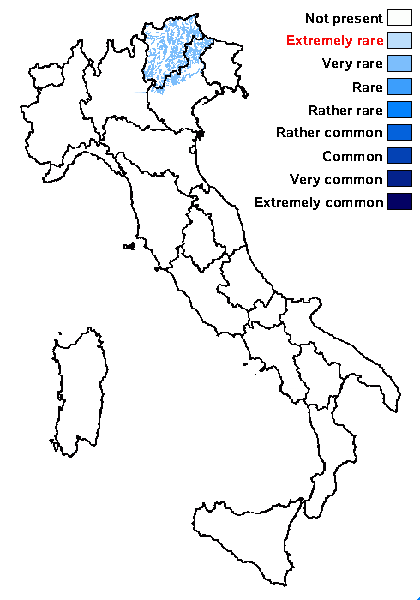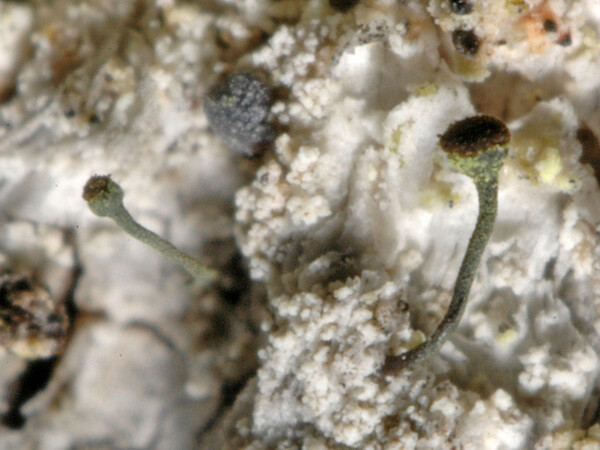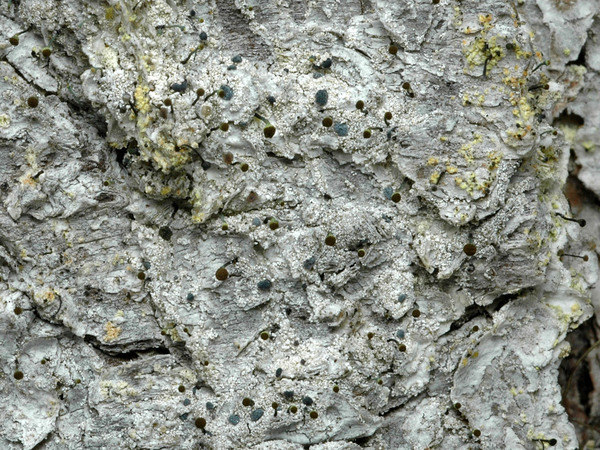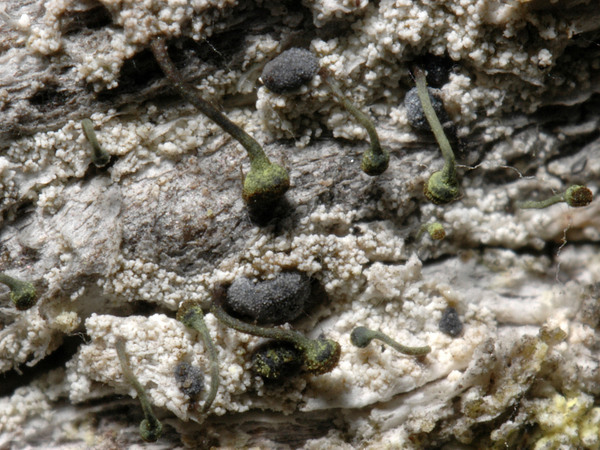Chaenotheca subroscida (Eitner) Zahlbr.
Cat. Lich. Univ., 1: 578, 1922. Basionym: Cyphelium subroscidum Eitner - Jahrb. schles. Ges. vaterl. Kultur, 88: 53, 1911.
Synonyms:
Distribution: N - Ven (Nascimbene 2011), TAA (Nascimbene & al. 2010, 2014, 2922, Nascimbene 2014, Nascimbene & Marini 2015, Trindade & al. 2021).
Description: Thallus crustose, thinly episubstratic, finely granulose to patchily flat-verrucose in older parts, appearing almost sorediate, pale grey (the verrucose parts pale brown), the granules 0.05-0.1 mm wide. Apothecia stalked, pin-like, (0.6-)0.8-1.3(-1.6) mm high, the stalk slender, (0.04-)0.06-0.08 mm thick, black in lower part, densely covered in a greenish yellow pruina in upper part, consisting of periclinally arranged, medium brown hyphae. Capitulum lenticular, 0.2-0.3(-0.4) mm across, yellow-pruinose on lower side, with a well-developed, brown mazaedium. Exciple well-developed, of periclinally arranged, sclerotized, brown hyphae; hypothecium medium brown, with a convex upper surface. Asci cylindrical, distinctly stipitate, formed from hooked ascogenous hyphae which mostly carry 2-3 asci each, dissolving early, with 1-seriately arranged spores. Ascospores 1-celled, brown to pale brown, globose, (4.5-)5-7(-8.5) µm wide, the wall with irregular cracks delimiting polygonal areas. Photobiont chlorococcoid, with globose cells. Spot tests: thallus K-, C-, KC-, P-. Chemistry: thallus without lichen substances or with pseudoplacodiolic acid; yellow pruina on the ascocarps consisting of vulpinic acid. Note: a rare species growing on the trunks of old conifers, more rarely on Betula, in upland areas, reported from the Eastern Alps. It is included in the Italian red list of epiphytic lichens as “Data Deficient” (Nascimbene & al. 2013c).
Growth form: Crustose
Substrata: bark and lignum
Photobiont: green algae other than Trentepohlia
Reproductive strategy: mainly sexual
In underhangs rarely wetted by rain
Commonnes-rarity: (info)
Alpine belt: absent
Subalpine belt: very rare
Oromediterranean belt: absent
Montane belt: very rare
Submediterranean belt: absent
Padanian area: absent
Humid submediterranean belt: absent
Humid mediterranean belt: absent
Dry mediterranean belt: absent

Predictive model
Herbarium samples
Growth form: Crustose
Substrata: bark and lignum
Photobiont: green algae other than Trentepohlia
Reproductive strategy: mainly sexual
In underhangs rarely wetted by rain
Commonnes-rarity: (info)
Alpine belt: absent
Subalpine belt: very rare
Oromediterranean belt: absent
Montane belt: very rare
Submediterranean belt: absent
Padanian area: absent
Humid submediterranean belt: absent
Humid mediterranean belt: absent
Dry mediterranean belt: absent

Predictive model
| Herbarium samples |
 INDEX FUNGORUM
INDEX FUNGORUM
 GBIF
GBIF
 DOLICHENS
DOLICHENS




